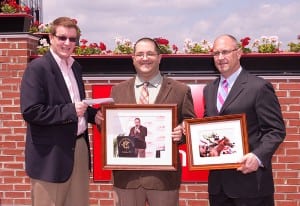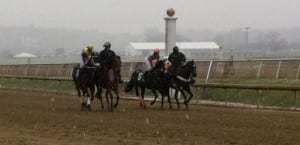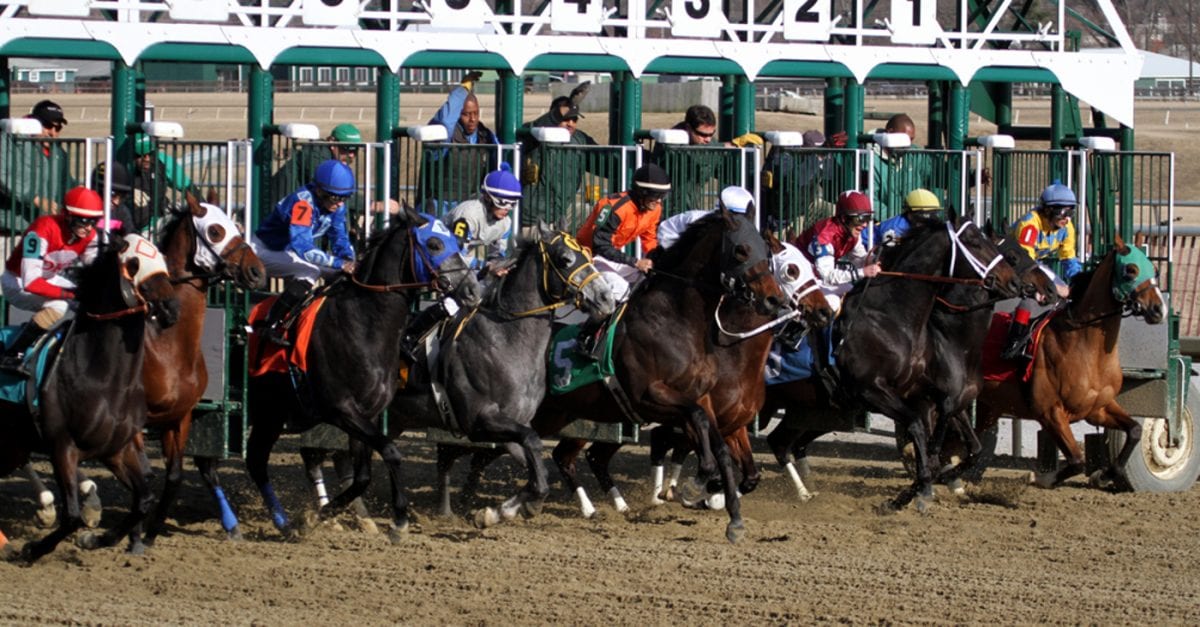
Maryland Jockey Club president Tom Chuckas (left), here along with Vice President-Communications Mike Gathagan (right) presenting Frank Carulli with parting gifts, sat down with The Racing Biz. Photo by Jim McCue, Maryland Jockey Club.
The last decade has been something of a roller coaster for racing nationally and, particularly, in Maryland.
A toxic combination of its own missteps and problems not of its own making saw Maryland sink to previously unimagined lows. The racing product declined, and handle plummeted. Horsemen looked elsewhere for their livelihoods, and breeding struggled.
But in the last couple of years, Maryland racing has gradually begun to find its way back. Slots revenue began to flow into the purse account and the bred fund, leading to rising purses and improving fields. The state Racing Commission flexed its muscle, helping shepherd through a 10-year deal between the horsemen and the racetracks and leading to an agreement to bolster bonuses for racing Maryland-bred horses.
As a result, handle on the live product rose in 2013 for the second consecutive year and has now risen by nearly 19 percent since 2011 — all while handle nationally has been essentially flat.
But to say there’s much to be done is something of an understatement. The 2013 daily average of about $2.2 million handled on the live product is well below the 2006 high of nearly $3.3 million.
What’s more, even while simulcast bettors have increasingly turned their attention to Maryland racing — and while on-track handle on the live product has more or less held its own — the import handle (money wagered in Maryland on races conducted elsewhere), which produces significant profit for the track, has declined substantially.
We sat down in mid-March with Maryland Jockey Club President and Chief Operating Officer Tom Chuckas to learn where Maryland is, what the company’s plans are, and what the future holds.
THE RACING BIZ: What’s your assessment of the last year or two?
TOM CHUCKAS: When you take a look at last year — the live product in-state held its own. That’s a positive in this market, in the racing market, because our product has gotten better. The import, we’ve taken a hit. it’s been a decline over the last two years. I attribute that to a large degree with the competition we face with the casinos. When Maryland Live opened up, we took a 27 percent hit here [on the import]. We took another significant hit when the table games came into play.
The good news is obviously the live program is getting better. A lot of things have occurred over the last years — the 10 year agreement, the owner-breeder bonuses will obviously help Maryland racing locally, the medication, another good thing. So you can see a lot of good things happening on the live product and our export.
CHUCKAS: Obviously, I would like to be much further along. But the product in Maryland took a lot of hits, both from a corporate perspective with certain uncertainties with the bankruptcy and the sale, to just in general with levels of purses that came into play due to the decline in the handle.
Under that scenario, there were years of decline The point is, the decline didn’t happen in a day, and the resurrection isn’t going to happen in a day. I’m happy with the progress we’re making. I’d like to be further along, but at least we’re making progress.
THE RACING BIZ: And on the import?
CHUCKAS: Overall, we’re making progress on the live and on the export. And the import is hurting us.
And the problem is, it’s not dollar for dollar; it’s what’s retained and split with the horsemen are different percentages. We retain more from the import than we do from the export. So you can have a scenario where handle looks flat across the board, but depending on what’s up and what’s down, it can hit us on the bottom line. That’s what’s happened in the last year or so – you’re not trading even dollars.
[pullquote]The decline didn’t happen in a day, and the resurrection isn’t going to happen in a day. I’m happy with the progress we’re making.” — Tom Chuckas[/pullquote]THE RACING BIZ: This winter meet has been the start of a new arrangement in which the horsemen are “buying” the days from the MJC, which runs the track for them. How has that process gone?
CHUCKAS: It’s gone smoothly. I think they have a much better understanding of what we’ve faced. I’m happy with what we’ve done because I think from their perspective, I think they see that we’ve worked diligently to try to make it successful.
It’s a tough time of year to race. We’ve had tremendous problems (with weather and track conditions) — we’ve done a real good job for them, and I think they appreciate that.
THE RACING BIZ: The MJC has made a couple of changes this year that I think some folks like and others aren’t so fond of. One of those has been the grouping of stakes races so that some Saturdays have three or four, while others have none. Do you think that this change is working?
CHUCKAS: I’m happy with that. It’s important to understand this is a process. Most of our customers that I talk to – they much prefer having three-four-five stakes in a day than a one-off.
THE RACING BIZ: It seems like it’s unclear whether it’s having a big impact on handle. Do you see much change?
CHUCKAS: One of the problems in racing is that if it doesn’t show a monumental success immediately out of the gate, there’s no endurance here, there’s no, “Let’s stick with this and really make it work.”
Hopefully, as the live product grows, there should be additional funds for the purse account, along with slots funds from new casinos coming online. As those funds increase, we can do more things with the stakes program, you can create and have more stakes. It’s the inception working towards the end
THE RACING BIZ: In addition to improving the quality of the racing product, another tool in your arsenal is implementing different wagers. To what extent is that something you look at?
CHUCKAS: We’re constantly looking for wagers that the public wants to do. We analyze and see where there are wagers that would generate more interest.
THE RACING BIZ: For example, the Jackpot Pick 5. How has that wager worked?

Difficult weather conditions wreaked havoc on racing schedules and racetracks across the mid-Atlantic. Photo by The Racing Biz.
CHUCKAS: We’ve come to find that Santa Anita and Gulfstream are somewhat unique with the pick players. The customers that wager on the Maryland product are much more win, exacta and trifecta. I can’t explain why.
In the fall, I think the Pick – I guaranteed 200 or something like that [after several days of carryovers], and you didn’t see any real huge push on the wagering until you got to closing day [when there was a mandatory payout].
Win bets, exactas, and trifectas are where the lion’s share of the money gets wagered
THE RACING BIZ: And another potential area, I would imagine, is improving the customer experience, sprucing up the facilities. Since we’re about to head to Pimlico, what can customers expect there in the years to come?
CHUCKAS: There’s constant conversations going about what Pimlico’s going to look like. There’s no one in the Stronach Group that doesn’t believe Pimlico needs a change. The real question is, what’s it going to look like?
Part of the problem is determining how much money to invest. You have a Baltimore city casino that’s going to open up, [so you have to consider] what’s going to be the impact of that? You want to build a first class facility that has all the bells and whistles, but it has to fit the marketplace. It’s hard to do that without knowing what the gaming facility is going to do.
PART 2 OF THIS INTERVIEW WILL BE PUBLISHED TOMORROW, APRIL 2.








What Mr. Chuckas seems to be blind to, or simply unwilling to correct, is the condition of his facilities. Now, I understand he acknowledges there are problems in his facilities but he needs to act instead of just acknowledging them. I’m not addressing the big issues, although there are plenty of those – I’m pointing out the little things.
For example, how about upgrading the TV sets that patrons watch the imported signal on. When I stand in the Laurel clubhouse, I see the same old tired wall of picture tube TV’s that were popular in the 80’s. The time has come for a wall of large flat screen tv’s. There is an overhanging wall just outside of the Horse Wizard room that is screaming for 3 or 4 big flat screens so that people can stand there and watch the import signal. If you can’t envision what I’m pointing out, Mr. Chuckas, make a visit to Delaware Park
How about keeping the clubhouse bar open beyond the end of the Laurel races? I’d like to stick around and play the Santa Anita import feed but if I can’t get a beer at the bar, I’m heading home for some HRTV.
How about putting some extra bar tables and chairs near the clubhouse bar so that patrons can sit down and relax.
I don’t believe Mr. Chuckas needs to “see” what his investment in items likes these should be based upon what the MD Live Casino does. It’s called basic customer service and providing some of the same comforts I have at home. It’s a simple decision that Mr. Chuckas doesn’t want to spend the money on – plain and simple.